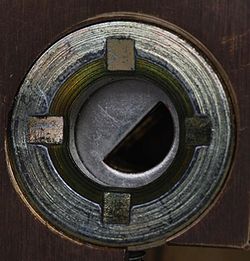Disc detainer
Disc-detainer

| This article may require cleanup to meet Lockwiki's quality standards. Please improve this article if you can. |
A Disc-detainer (or disc lock, disk lock) is a lock design that uses rotating discs as locking components. In most designs the discs interface with a sidebar when properly rotated to allow them to actuate the locking bolt. Disc-detainers are primarily associated with Abloy locks, but ABUS, Kryptonite, and many knock-off brands have begun making them, too.
History
The first disc-detainer lock was the Abloy Classic, invented by Emil Henriksson in 1907.
Add to me!
Principles of Operation
Disc detainer keys have angled bitting cuts that rotate discs. When rotated properly, a sidebar will fall into a gate on the discs allowing the key to turn further and actuate the locking bolt to lock or unlock the lock. Master keying is provided by wide or duplicate true gates on the discs themselves.
Discs in the unlocked position; the sidebar can be retracted.
Vulnerabilities

Disc-detainers are subject to all the same attacks as traditional lock designs, though the tools used are less common. Lockpicking tools designed for disc-detainer locks closely resemble the 2-in-1 or 3-in-1 picks used with lever locks. The main anti-lockpicking feature of disc-detainers is the use of false gates (or notches), but more advanced designs include a disc locking system that prevents discs from being individually manipulated.
Given the proper tools and skill, all disc-detainer locks are subject to one or more of the following:



